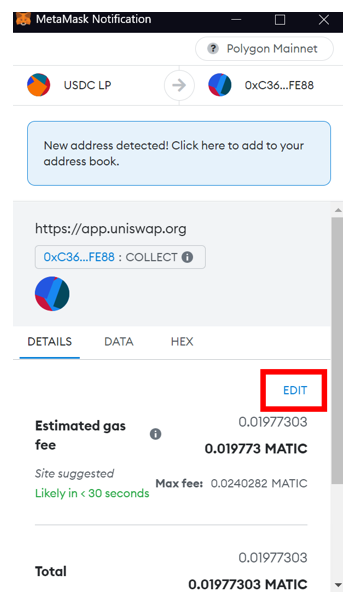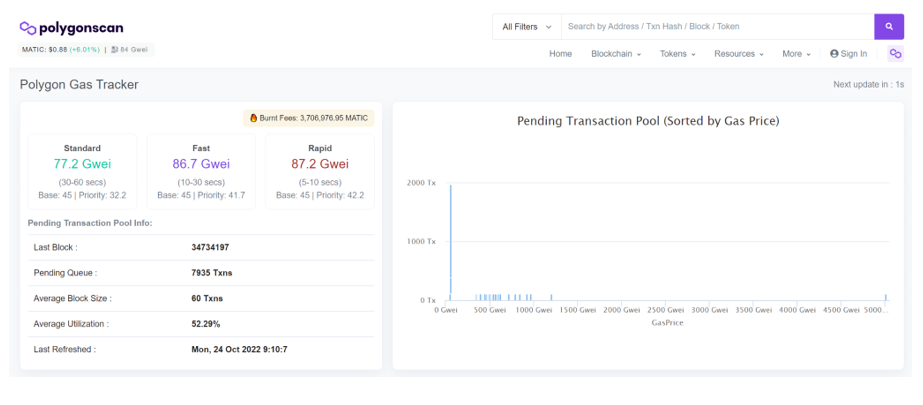 |
| By Chris Coney |
Blockchain network capacity is a scarce resource … so it typically goes to the highest bidder.
But what if your wallet is a lousy bidder? You could end up frustrated with slow transactions and not know why.
To eliminate this frustration almost entirely, overpaying for blockchain transaction fees has become second nature to me.
But why on Earth would I intentionally pay more in fees for the same service?
Well, this habit formed during the last crypto bull market when networks were jammed with traffic.
In particular, Polygon (MATIC, Tech/Adoption Grade “B-”) was doing pretty well at the time, because it was absorbing a lot of the overflow demand Ethereum (ETH, Tech/Adoption Grade “B”) couldn’t handle.
This was a time before EIP-1559 — also known as the London upgrade, an ETH protocol that calculates the base transaction fee for you, therefore making these fees more predictable (but not cheaper) — was in effect.
Back then, finding out what your fee should be was an absolute nightmare. That’s because the moment you submitted a transaction, a flurry of high-fee-paying traffic could rush to the network and push your transaction to the back of the line.
Understandably, this could quickly turn a nice, pleasant blockchain experience into a sour one. Much like running into a horde of traffic while on a nice drive.
Now, the EIP-1559 upgrade has smoothed out transaction fees by causing them to rise and fall more gradually over time. Additionally, wallet software does its absolute best to estimate what the transaction fee should be so the transaction confirms quickly without breaking the bank.
However, I often find that EIP-1559 doesn’t give me the user experience I want … so I’ve turned to setting my transaction fees manually.
This is especially helpful for transactions that are incredibly time sensitive, because even waiting 15 seconds for an ETH transaction confirmation can mean the difference of hundreds or thousands of dollars — depending on the amounts you’re dealing with.
Take something as simple as a swap transaction on a decentralized exchange. You’re not guaranteed to receive the amount you’re quoted, because after submitting the transaction, the price may change.
Therefore, the faster our transaction confirms, the closer to the quoted price we will get.
I originally chose to bid higher fees on these types of transactions due to the importance of timing, but now I just do this for all transactions.
The Polygon network works best for the trick I’m about the share with you because its individual transaction fees tend to be much lower than Ethereum’s. For instance, if transaction fees are 1 cent on Polygon and we pay double, we still only end up paying 2 cents total.
Meanwhile, if an Ethereum transaction is $1.50, then doubling our bid means each transaction costs $3. Again, depending on the amounts you’re dealing with, ETH may be the better option.
We still have to double-check this on a transaction-by-transaction basis.
Thankfully, this process only takes a few seconds to complete and will soon become second nature to you as well.
Step 1. Propose your transaction as normal and wait for the MetaMask pop-up to appear. Click EDIT next to Estimate gas fee, then Advanced Options.

Step 2. Locate the Max priority fee and Max fee boxes:

Step 3. Open a new browser tab and go to this website.
After visiting that site just once, simply typing “gas” into your address bar should cause your browser to suggest the full link to you from your browsing history.

Then, identify the upper range for transaction fees given current network conditions. In this case, the reading is 87 GWEI.
Now enter a number into the Max priority fee and Max fee boxes that we left on the other tab. Enter a number greater than the highest fee band.
In my example, the reading was 87, so I would bid 97. This gives me an additional margin in case the upper band creeps up while I’m entering the numbers.
Finally, click Save and you can submit the transaction. This should ensure your transaction gets confirmed in the very next block.
Like I said at the outset, this most definitely will cost you more money for the same transaction. What we have done here is akin to going to the gas station and choosing to pay 10 cents per gallon more to fill our tank.
While that may sound crazy, if the gas station was jam-packed and every pump was being used, some people would be more than willing to pay the extra 10 cents per gallon to be served first. In some instances, the time saved is worth a whole lot more than the extra cost.
Just bear in mind the tool I’ve given you to look up transaction fees relates to the Polygon network. If you want to try this trick with the Ethereum network, you may do so on this website.
But that’s all I’ve got for you today. Let me know if you think overpaying transaction fees is worth it by tweeting @WeissCrypto.
I’ll catch you here next week with another update.
Kind regards,
Chris Coney

